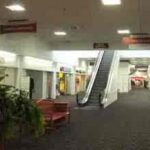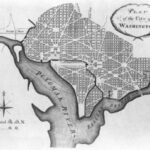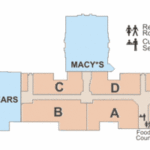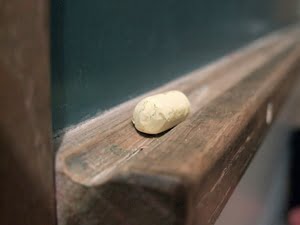Old malls never die, they just shut their doors. While Tampa, Florida, has seen a number of malls rise and fall over the decades, Tampa Bay Center seems to have maintained quite a following, years after its closure, among nostalgic folks.
Tampa Bay Center was a two-story indoor shopping mall that opened in 1976, right across the street from Tampa Stadium. Tampa Stadium was the old home of the Tampa Bay Buccaneers professional football franchise. The connection of the Tampa Bay Buccaneers and Tampa Bay Center is significant, both in symbolic and physical respects. Read on to find out more about the mall and its important Buccaneers connections.
About the Mall
When the 877,000-square-foot Tampa Bay Center opened in 1976, it became Tampa’s fourth major indoor mall, following South Tampa’s Westshore Mall in 1967, North Tampa’s Floriland Mall in 1972, and University Mall in 1974 — located only blocks from the University of South Florida in North Tampa. Tampa Bay Center was located at the southeast corner of North Himes Avenue and West Buffalo Avenue (in 1989, Buffalo Avenue was renamed Martin Luther King, Jr., Boulevard).
Tampa Bay Center stood out from the other Tampa malls in a number of ways. It was one of the few two-story malls in the Tampa area, and unlike the other malls at the time, its main corridor was splashed in sunlight. A large portion of the roof was actually constructed with skylights; a bright and sunny day outdoors meant a bright and sunny day indoors—an inviting feature at a time when many malls were being built with dropped ceilings and finished with darker colors.
The mall featured exposed, light-colored truss ceilings over the main corridor, tan-brown floor tiles, floor-based water fountains, and trees (ficus?) intermittently planted on the bottom floor of the main corridor, growing upwards toward the skylights. The open-and-airy interior was further augmented by what was one of the mall’s most important trademarks: a “glass” elevator located in the center of the mall.
When Tampa Bay Center first opened, it featured two anchors: Sears-Roebuck and Burdines (a Florida-based clothing chain later recently bought out by Macy’s). In the early 1980s, Montgomery Wards built and moved into its store location directly opposite the mall’s main Buffalo Avenue entrance. Sears was located on the western end of the mall, and Burdines’ store was on the east end. The corridor ran the equivalent of a few city blocks and, with two stories of shopping floor, contained several dozen stores. There was also a two-screen movie theater on the first floor and, in circa 1987, one of the area’s then-largest food courts, opened on the second floor near the Buffalo Avenue entrance.
Tampa Bay Center was arguably the place to shop during its heyday. Its central location in Tampa, roughly equidistant between Tampa’s trendy southern neighborhoods and more affluent northwestern suburbs, allowed Tampa Bay Center to enjoy consistently large crowds. The Christmas season at Tampa brought choir groups to sing at the mall, Santa Claus, and plenty of joyous and wintry decorations. Around 1990, the mall brought in a double-decker, vintage carousel, which was located at the center of the mall on the first floor.
The Decline
The mall was beset with problems as the 1990s wore on. The mall faced scrutiny by some in the local black community in the mid-1990s because the mall’s management decided to close early on the day when two black college football teams played in the Florida Classic bowl game at Tampa Stadium across the street. Though this incident mired the mall in some local controversy, this event is not what necessarily led to the mall’s eventual demise.
What did the mall in? Those familiar with the mall remember well a pattern of shifting demographics, the opening of new shopping destinations, and bankruptcies that hit some stores, including one of the anchors. Citrus Park, a rural outpost in northwestern Hillsborough County as recently as the early to mid 1980s, had found itself amid tremendous growth by the 1990s. Citrus Park Mall, now called Westfield Shoppingtown Citrus Park, opened in 1999 and took the Tampa Bay Center Burdines location in. With the Burdines anchor gone, Tampa Bay Center began reeling from the loss of a major store and a troubling trend: those visiting the mall were not necessarily buying anything. Neighborhoods nearby Tampa Bay Center were changing as many of the longtime residents were aging or moving to neighborhoods further from Tampa Bay Center.
This trend had been occurring throughout the 1990s, but had become especially pronounced as the decade moved on. However, with a mall full of stores and all three anchor buildings occupied with big-name retailers, the mall still looked and felt healthy. With Burdines gone, though, the tide looked to be turning on the mall.
In 2000, news that the venerable Montgomery Wards chain was closing all its stores hit Tampa Bay Center very hard. This meant the closing of a second (of, again, only three) anchors and the loss of a major, longtime tenant. While the hope for a mall revival is always possible when an aging mall loses anchors, hope just was not there for Tampa Bay Center, situated less than two miles away from an old golf course near Tampa International Airport that was, in 2000, already being cleared for International Plaza, a mall that would go on to become one of the region’s most popular shopping malls.
Low rents kept only a dwindling corp of stores in Tampa Bay Center, and shoppers no longer were drawn to the once-magnetic shopping destination. By the start of 2002, International Plaza had opened, stores were leaving en masse from Tampa Bay Center, and Sears, the last remaining anchor (and one of the last stores, period, to remain at the mall by that time) announced it would be moving to Westshore Mall in the South Tampa/Westshore area of Tampa. Westshore Mall and, by 2002, not only experienced massive renovations leaving the mall almost unrecognizable from its former self, it had survived the mall wars of Tampa–even fending off competition from International Plaza barely more than up the street to the north.
Sears opened in the former Dillard’s Department store location on the east side of Westhore Mall, and with the store Tampa Bay Center officially closed its doors after serving Tampa shoppers for over a quarter of a century. The mall that at one point was one of Tampa area’s most popular malls found itself sitting in the middle of a shifting neighborhood and unable to draw new, major tenants.
The closure of Tampa Bay Center and its eventual demolition marked the end of an era for Tampa, but the mall lives on both in memories and, in a small way, at the Sears at Westshore Mall. Sears installed a “glass” elevator in its Westshore store that, in many respects, resembles the popular feature at Tampa Bay Center. And, to date, one can still find Tampa’s typical, green road signs along Martin Luther King, Jr., Boulevard and Himes Avenue that, respectively, bear “Tampa Bay Center” and “Sears” at the traffic-signaled intersections which at one point saw hundreds of cars a day pouring in and out of the mall property.
The Buccaneers-Mall Connection
The mall was demolished over the spring and summer of 2005 and the Buccaneers moved into their new facility in time for the 2006 football season. Encompassing only about half of the mall’s 80-acre property, the western portion of the land was turned into a parking lot designed for stadium crowds. The Buccaneers now train in what is considered to be one of the NFL’s top facilities.
The Tampa Bay Buccaneers first played in the NFL in 1976, the same year as Tampa Bay Center opened, and not only helped bring plenty of shoppers to the mall on Sundays, but plenty of cars, too. Though the Buccaneers had plenty of losing seasons, it seems parking was always scarce, and Sundays in the autumn meant cars at the mall’s parking lot. Home games played during the Christmas shopping season made finding a place to park the car at the mall all the harder.
Tampa Stadium was demolished in 1999 following the Buccaneer’s first season (1998-99) at Raymond James Stadium just yards to the south. Though the Buccaneers made a step up to a state-of-the-art stadium, they were still training at a facility (also built in 1976) that was, by the late 1990s, considered to be less-than cutting edge. Players were lifting weights under tarp roofs outdoors, fending off rats in the training facility’s hallways, and sharing lockers. Perhaps “roughing it” at old “One Buc Place” helped give the team enough grit to win Super Bowl XXXVII, but the aging, cramped training facility was deemed inadequate.
With Tampa Bay Center having closed its doors in 2002, it was little surprise that the Glazer family, the owners of the Buccaneers, soon purchased the mall. Following a disappointing 2004 season, Buccaneers head coach Jon Gruden sat inside a steam shovel and struck the first blow against the mall by tearing down the yard-wide (interesting football connection, is it not?) aluminum exterior panels that comprised the facade of the old Burdines department store building.
Resources:
http://www.bizjournals.com/tampabay/stories/1996/07/29/story3.html?page=1
http://www.sptimes.com/2003/01/18/TampaBay/Glazer_paid_228_milli.shtml







